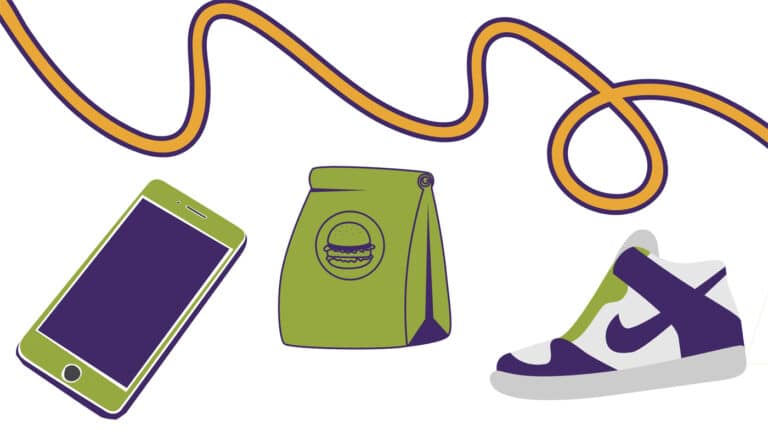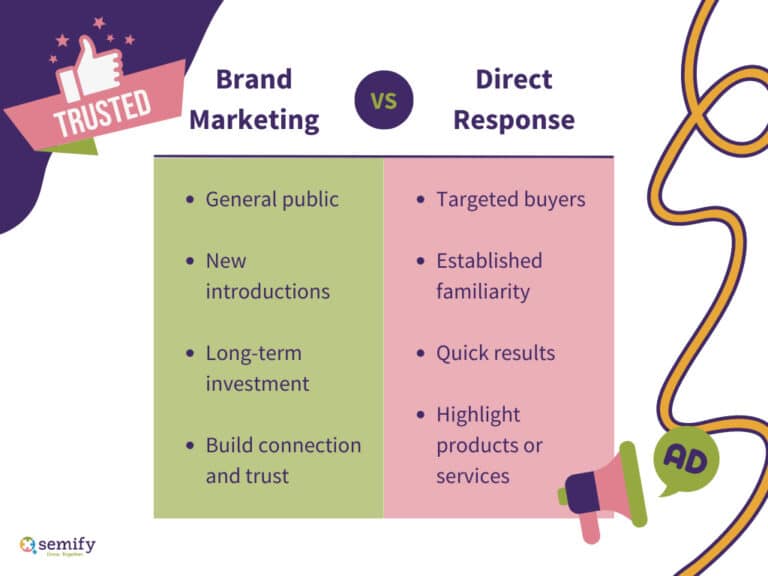
Whether you’re helping a small business owner or you’re trying to get new clients for your own agency, you’ll have to highlight how to solve customer problems. But that comes down to more than offering the best products and services for the best possible price. Sometimes, you may not even be looking to drive immediate sales. Depending on where the customer is in their buyer’s journey, you may need to take some specific steps to improve brand perception before someone is ready to make a purchase.
This all comes down to choosing between direct response marketing campaigns and building brand awareness. And while it’s entirely possible to do both at the same time, you’ll still need to decide whether a given part of your strategy falls under brand content marketing or under direct response digital marketing. Understanding the greater purpose of each strategic component can help you make stronger, smarter choices along the way.
If you’re feeling a little lost, don’t worry. As your white label SEO partner, we’re breaking down these terms to help you make the right moves for your agency and for your clients.
What is Brand Marketing?
First, let’s talk about brand marketing. In its simplest form, brand marketing refers to how a business develops a relationship with its customers. The idea here is two-fold: to differentiate your brand from others in the marketplace and to build a real connection with consumers.
When you develop a brand content strategy, you won’t be focusing on the products or services the business provides. Rather, you’ll be coming up with ways to promote the brand as a whole. Generally, that involves establishing and highlighting the unique attributes of your brand in ways that resonate with and provide value for your target audience.
Why Does Brand Content Marketing Matter?
Think about some of the most well-known brands in the world – like Apple, McDonalds, and Nike – and ask yourself: are they loved and revered specifically for their products or services? Or are these offerings actually secondary to something greater?
Arguably, the most successful companies are selling something more than cell phones, hamburgers, and sneakers. They’re selling a lifestyle. A promise. A dream. Will the newest iPhone, a Big Mac, or a pair of Air Maxes really change your life? Probably not in any meaningful way. But if you’re a fan of these brands, you can’t resist the allure of what might be.
All three of these companies understand the importance of brand marketing. Of course, they know how to promote their latest releases. But the reason those releases are so successful is because there’s a solid foundation of brand marketing on which to build those promotions.
Brand marketing is what encourages emotional buy-in. Although we sometimes like to tell ourselves that brand loyalty is dead, that isn’t really true. It’s just a lot harder to come by these days. With so many options available, brands have to stand out from the crowd – and do more than merely sell a product. They need to sell what the brand represents.
There are a lot of companies out there that have managed to build their brand equity to the point where their customers won’t even think about looking elsewhere for similar products or services. From Trader Joe’s to Coca Cola, these brands manage to not only establish their own distinctive identities but actually become an integral part of their customers’ identities. Trader Joe’s fans are reluctant to shop elsewhere for groceries, while Coke drinkers would never be caught dead sipping on a Pepsi. That’s not necessarily because these products are objectively better; it’s because consumers identify with the brand itself.
So with that in mind, why does brand content marketing matter? Because without it, you’re just another business providing the same products or services as your competitor. When done well, brand marketing will strengthen a customer’s emotional connection to your company. And that’s what makes the difference between a one-time purchase and a lifelong buyer.

What’s Involved in Brand Marketing?
Getting your audience to love your products is one thing. But getting them to love your company is another. And because today’s consumers tend to be skeptical by default, it’s tougher than ever to convince buyers to make the leap and trust you.
Before anyone can even like your brand, however, it needs to be clearly established. If you’re confused about your brand attributes (like your visual identity, your values, your persona, your voice, and anything else that makes your brand unique), your prospects will be confused, too. It’s crucial to get into the nitty gritty of your brand and your audience before you attempt to market it. If you don’t know your brand like the back of your hand, you’re going to have a tough time convincing customers to come along for the ride.
This may require you to undergo a brand refresh or even a complete rebranding, in some cases. (We rebranded to Semify back in 2020, so we know how big an undertaking it is!) Your agency or your clients may not need a totally new name, but it may be worth exploring whether there are attributes that can be updated to accurately reflect the direction of the company. If the logo, tagline, mission statement, or overall ethos doesn’t speak to you, it definitely won’t speak to prospective customers.
Once you’re clear on what makes the brand unique, you’ll typically want to create a strategy around building brand awareness, brand loyalty, and other goals. Remember: the objective of brand marketing isn’t necessarily to directly make more sales. You might be more focused on improving web traffic, boosting your customer Net Promoter Score (NPS), increasing engagement on social media, or establishing authority through thought leadership.
What Are Some Common Brand Awareness Content Ideas?
Let’s say you’ve done all that prep work and are now in need of some brand awareness content ideas for your brand marketing strategy. Brand marketing content may involve:
- The imagery, colors, font, and logos associated with your business
- Infographics
- Review management programs
- Partnerships with other businesses
- Sponsorships and charitable work
- Branded product giveaways
- Behind-the-scenes visual media
- Social media contests
- Case studies and ebooks
- Informative blog posts
- LinkedIn courses and published posts
- Podcasts or webinars
- Posts related to social or environmental causes
Can these tactics sometimes result in sales for the business? Sure. But that’s not the #1 goal. All of these examples can help brands connect on a deeper level with potential customers and position the company as a leader or even a friend.
According to a study from Sprout Social, that connection matters. Around 57% of consumers say they’ll increase their spending with a brand that they feel connected to, while 76% say this connection will convince them to buy from that brand over a competitor. When you prioritize brand marketing, you’ll ensure that the other aspects of your strategy are that much more effective.
That being said, brand marketing isn’t the only thing you’ll need for a successful strategy. Direct response marketing also has its place in promoting your agency or your clients’ businesses.
What is Direct Response Marketing?
Direct response marketing, sometimes called direct response advertising, intends to elicit (you guessed it) a direct response from a customer – namely, a sale. Rather than having a goal of increasing general awareness, direct response marketing is all about influencing behavior directly and immediately.
Unlike with brand marketing, direct response marketing campaigns will usually feature more of a “hard sell.” It’s not meant to be subtle; while direct response marketing can be educational and will demonstrate value, it’s also intended to drive results almost instantaneously. As the name suggests, there should be a direct and identifiable link between the promotion and the desired result (i.e., web traffic and/or sales).
Why Use Direct Response Marketing?
Although many of today’s customers don’t like obvious sales tactics, direct response digital marketing is both appropriate and necessary in a number of scenarios. It’s generally a more effective option when a brand is trying to influence certain behaviors or attain more quantifiable, immediate goals. If there’s a sense of urgency surrounding your desired outcome, chances are good that direct response marketing may be the right choice.
Whether you’re trying to generate more leads, sell more products, or get more folks to sign up for your email blasts, you’ll want something with a strong call-to-action. CTAs are a hallmark of direct response marketing campaigns because they tell the customer exactly what you want them to do next. Instead of an open-ended, informative article that may show your brand in a positive light, you’re guiding the consumer through their buyer’s journey with your company.
Not only does direct response tend to produce faster results, but those results are also easier to track. While there are KPIs that can measure brand awareness and loyalty, they may be a bit more subjective or out of your control. With direct response marketing, on the other hand, you can see exactly how successful each campaign is and how much you’re spending to target each customer. On that note, direct response marketing provides more accurate targeting and personalization than brand marketing. Because you’ll have more data at your disposal, you can reach specific audiences more effectively – resulting in greater conversions.

What Are Some Direct Response Internet Marketing Examples?
Direct response marketing might make you think of your basic advertisement, but it’s more than that. Here are just a few direct response internet marketing examples you might already be familiar with:
- Product and landing pages
- Google Ads (PPC) or display advertising
- Social media advertisements
- Special offer email blasts or targeted emails (i.e., cart abandonment, remarketing)
- New product launch announcements
- Newsletter enrollment pop-ups
- Customer referral programs
- SMS (text message) marketing
- Chatbots and social media messaging platforms
It’s not just digital marketing that uses direct response principles. Materials like promotional mailers would also fall under the category of direct response marketing. Additionally, print ads, radio spots, and TV commercials would be categorized this way. While these might seem outdated, many businesses still use them to diversify their strategies and reach certain key demographics.
Branding Vs Direct Response: Which Should You Choose?
Understanding the difference between direct response marketing vs branding is only half the battle. You’ll need to know which type of marketing to focus on at any given point in your strategy – and that choice isn’t always as straightforward as it might seem. Here are a few ways to determine which option is best for your needs.

Audience
Brand marketing is a great equalizer, allowing you to reach all kinds of people with a singular piece of content. When you’re looking to introduce your brand to the general public, brand marketing is the natural choice. But if you’re at the point where you need to target specific buyers, direct response marketing can help you segment your audience and zero in on the folks who are ready to purchase.
Buyer’s Journey
When a consumer isn’t yet familiar with your brand, you need to put in the legwork to build trust, authority, and likeability. That’s what brand marketing is all about. Before you ever try to sell them on a product or service, these prospects need to know and love you. But if they’ve already been introduced to your brand and made up their mind that they connect with you, it’s time for direct response marketing. Now that they’re further along in their buyer’s journey, they’ll be ready to hear why your offerings will change their lives for the better.
Timeline
In the SEO vs. PPC debate, one of the main differences is time efficiency. The comparison between brand marketing and direct response is similar. Both SEO and brand marketing take longer to build, but their effects are longer lasting. In contrast, PPC and other direct response marketing techniques have more immediate results. The downside is that after those campaigns have ended, you won’t keep driving sales or traffic. (This illustrates why you need both types of marketing in your strategy!) If you’re promoting a short-term offer, direct response should be your top priority. But you can’t rush building your brand awareness. As they say, Rome wasn’t built in a day.
Goals
One of the easiest ways to establish the winner in your branding vs direct response race? Zero in on exactly what you’re trying to accomplish. If you know you need to make a certain amount of sales as soon as possible, you may want to prioritize a direct response strategy. Not only will this highlight specific products or services, but you’re directing customers to take a very specific action (a.k.a. making a purchase). On the other hand, if you’re still trying to reach a certain demographic and you aren’t focusing on immediate sales, brand marketing might be the strongest choice. With your brand content marketing, you can build connections and trust with your audience without the pressure of a hard sell.
In Direct Response Marketing Vs Branding, It’s Not Either/Or
In the branding vs direct response argument, you don’t need to take only one side. You’ll ultimately need to cover both marketing types for any strategy, whether it’s for your own agency or on behalf of a client. But which one you choose at any given point will largely depend on the specific goals (both immediate and long-term) you want to achieve. And in many cases, you may be working on both at the same time!
When you partner with a white label SEO provider to outsource your client marketing, you’ll want to have a clear understanding of whether the content will be largely focused on branding and education versus direct response. Some pieces may have elements of both. By and large, though, the majority of optimized blog content will be geared towards building trust and providing value. On the other hand, content like web and ad copy will usually fall under the direct response umbrella.
In the end, one isn’t inherently better than the other. Each type of marketing serves a different purpose – and both are crucial to a successful strategy. When you decide to employ one over the other is a totally personal choice, but you should plan to include both when marketing any business online. And knowing which one to recommend or utilize at any moment will solidify your leadership as a marketer to watch.